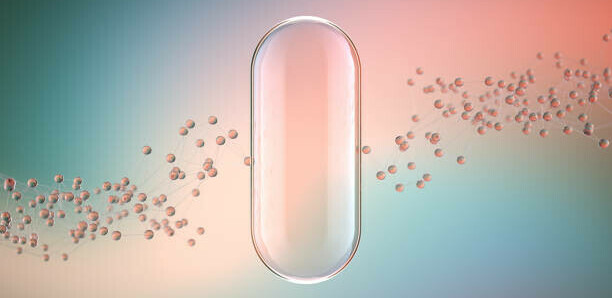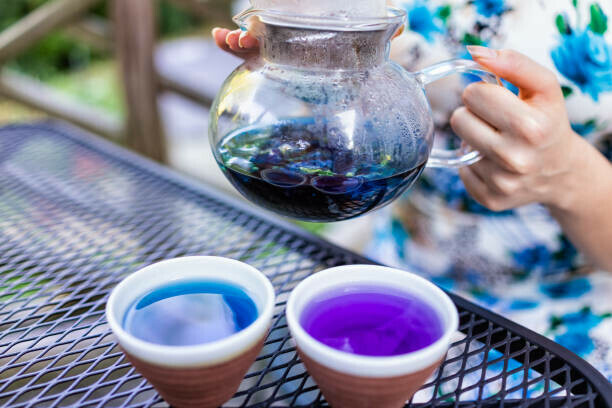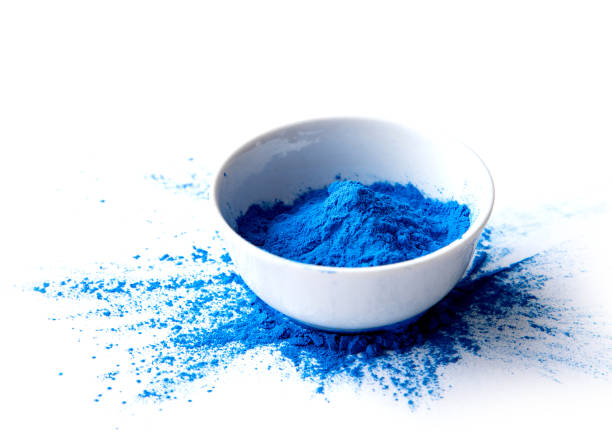Today, I’d like to talk to you about “Blue Tea Side Effects”. Blue tea has attracted the interest of enthusiasts and health-conscious individuals due to its striking color and fascinating origins. It is made from the butterfly pea flower (Clitoria Ternatea). Its vibrant color and possible health advantages make it a valuable contribution to the world of well-being.
Originating from Southeast Asia, blue tea has been esteemed for centuries for its natural beauty and therapeutic characteristics. The butterfly pea flower, the critical component of blue tea, is renowned for its vivid blue petals that turn water into a captivating blue beverage. This visually appealing drink has gained popularity among tea fans and has also been utilized in the culinary world to create visually stunning dishes and drinks.

The butterfly pea flower contains anthocyanins, compounds responsible for its vivid color. Anthocyanins also serve as antioxidants, which help neutralize harmful free radicals in the body, potentially lowering the risk of chronic diseases. Owing to its high antioxidant content, blue tea may contribute to improved cardiovascular health, enhanced brain function, and better skin health. Furthermore, the soothing properties of the butterfly pea flower make blue tea an excellent choice for individuals looking to alleviate stress and anxiety.
Moreover, blue tea offers a unique sensory experience; its captivating color can shift to purple with lemon juice, creating a visually magical effect. This color-changing feature adds fun to your tea-drinking experience and accentuates the natural acidity of the lemon juice, enhancing the overall flavor.
Blue tea is also recognized for its subtle, earthy taste with a hint of floral sweetness, making it a versatile beverage suitable for both hot and cold consumption. Whether enjoyed as a comforting warm tea or as a revitalizing summer beverage over ice, blue tea provides a delightful experience for the senses.
Incorporating blue tea into your daily routine is a straightforward and effective way to enjoy a healthful beverage that delights the palate and promotes overall well-being. With its rich history, stunning appearance, and numerous health benefits, blue tea truly stands out as an extraordinary infusion that is certain to enchant and nourish both the body and the soul. So, why not embrace the vibrant world of blue tea and experience the magic for yourself?
The Safety Profile of Blue Tea: Is It for Everyone?
Blue tea, an intense infusion created from the butterfly pea flower, has attracted attention due to its remarkable color and potential health advantages. However, like any dietary addition, assessing its safety profile is crucial to guarantee it is suitable for everyone. Understanding the general safety considerations, potential allergies, and specific guidelines for certain groups can assist you in making well-informed decisions about integrating blue tea into your daily routine.
For the average consumer, blue tea is usually well-tolerated and safe when consumed in moderate quantities. The primary ingredient, the butterfly pea flower, has been traditionally used in Southeast Asia for many years without significant adverse effects. Abundant in antioxidants and free from caffeine, it provides a gentle alternative to more stimulating beverages, making it a suitable option for those seeking a soothing and healthful drink.

It’s important to note that individual sensitivities and allergies can arise. While uncommon, some individuals may encounter mild allergic reactions to the butterfly pea flower, such as skin rashes or digestive discomfort. Suppose you have a known allergy to flowers in the Fabaceae family, to which the butterfly pea belongs. In that case, it’s recommended to consult a healthcare professional before trying blue tea. Conducting a patch test or starting with a small amount can help assess your body’s reaction.
Certain groups should approach blue tea with particular care. Pregnant women, for example, are often advised to limit their consumption of herbal teas due to the lack of extensive research on their safety during pregnancy. Even though there is no definite proof indicating the adverse impact of butterfly pea flowers on pregnancy, it is advisable to remain vigilant and seek advice from a healthcare professional.
Similarly, children should consume blue tea in moderation. While the drink is generally safe, their smaller bodies may respond differently to herbal infusions, and moderation is vital to avoid potential adverse effects. Additionally, individuals on medications, particularly those that affect blood sugar levels or blood pressure, should consult their healthcare provider before adding blue tea to their diet. The butterfly pea flower has been observed to potentially impact these parameters, and it’s crucial to prevent interactions with prescribed medications.
In summary, blue tea is an aesthetically appealing and healthful beverage that is generally safe for most individuals. However, being mindful of individual sensitivities and specific guidelines for certain groups can ensure everyone enjoys this colorful infusion safely. When adding new items to your diet, seeking guidance from a healthcare provider to tailor recommendations to your health requirements is essential.
When Too Much of a Good Thing Becomes Bad: Overconsumption Issues

With its captivating color and numerous health advantages, blue tea is a beautiful addition to any eating plan. Nevertheless, as with any nutritious drink, excessive consumption can transform a positive thing into a source of discomfort. Understanding the potential problems linked to too much intake of blue tea, particularly concerning gastrointestinal problems, blood pressure, and blood sugar levels, emphasizes the significance of moderation when enjoying this lively beverage.
Drinking large amounts of blue tea can result in gastrointestinal problems. Although the butterfly pea flower is gentle in moderate quantities, it can cause bloating, stomach pains, or even diarrhea if consumed excessively. This is mainly because of the body’s response to the tea’s high concentration of herbal compounds. For individuals with sensitive digestive systems, monitoring consumption and paying attention to your body’s signals is vital, as well as adjusting intake to avoid adverse effects.

In addition to potential digestive problems, excessive intake of blue tea may impact blood pressure and blood sugar levels. The butterfly pea flower is recognized for its capacity to reduce blood pressure, which can benefit individuals with high blood pressure. However, overconsumption may lead to low blood pressure, dizziness, fainting, and light-headedness. Similarly, the potential of blue tea to lower blood sugar levels can be a two-edged sword. While it may help in managing blood sugar levels for some, overindulgence could lead to low blood sugar, especially in individuals taking diabetes medication. Warning signs of low blood sugar can consist of trembling, disorientation, and, in extreme situations, loss of awareness.
Moderation is crucial to enjoying the benefits of blue tea without experiencing adverse effects. Experts advise consuming one to two cups of blue tea daily. This quantity allows you to benefit from the antioxidant and stress-relief advantages without overwhelming your system. For those new to blue tea, beginning with one cup per day and gradually increasing to two cups can help your body acclimate to this herbal infusion.
When done thoughtfully, adding blue tea to your everyday schedule can be a pleasant and advantageous habit. By comprehending the importance of moderation and the potential issues of overindulgence, you can fully appreciate this vibrant beverage, enhancing your well-being without compromising your health. Please always consult your doctor if you have any existing health conditions or questions about adding blue tea to your diet. By doing so, you can safely and healthily embrace the world of blue tea.
Interactions and Contraindications: Blue Tea’s Relationship with Medicines

Blue tea is well-known for its vibrant color and health advantages, making it a captivating addition to any eating plan. However, it’s essential to carefully consider its interaction with certain medications and its unsuitability for those with pre-existing medical conditions. Understanding these interactions from a pharmacological perspective is crucial for safely incorporating blue tea into your routine.
The butterfly pea flower is used to make blue tea, and it is recognized for its high anthocyanin content, which is responsible for its striking color. While these anthocyanins are beneficial, they can interact with various medications. For example, the natural compounds in the butterfly pea flower have mild blood-thinning properties. This can intensify the effects of anticoagulant or antiplatelet drugs, potentially leading to an increased risk of bleeding. Remember to keep an eye on your intake of blue tea and consult with a healthcare provider if you are using blood thinners like warfarin or aspirin.

Moreover, blue tea’s potential to reduce blood pressure may pose difficulties for those on antihypertensive medication. The combined effect of the tea and the medication can result in shallow blood pressure, leading to dizziness, fainting, and fatigue. Similarly, for those on medications to control blood sugar levels, blue tea may enhance the effects, increasing the risk of hypoglycemia. Diabetic patients should approach blue tea with caution and under medical supervision.
Individuals should be careful when consuming blue tea if they have pre-existing medical conditions. For example, those with liver or kidney disorders should avoid consuming large quantities, as their body’s ability to metabolize and excrete the compounds in butterfly pea flower may be compromised. Pregnant and nursing mothers should refrain from consuming blue tea unless instructed otherwise by a healthcare professional due to the scarce research on its safety for these groups.
Seeking guidance from healthcare professionals before incorporating blue tea into your routine is essential. Personalized guidance is available according to your health condition and the medications you are taking, allowing you to experience the advantages of blue tea without any adverse effects.- Personalized guidance is available according to your health condition and the medications you are taking, allowing you to experience the advantages of blue tea without any adverse effects. By taking these precautions, you can seamlessly integrate this beautiful and healthful beverage into your diet, enhancing your well-being while safeguarding your health. Embrace the enchanting world of blue tea, but do so with informed mindfulness to fully enjoy its rewards.
Embracing the Blue Without the Blues: Ensuring Safe Consumption

Blue tea is a pleasant addition to your wellness routine due to its stunning color and health benefits. However, to fully enjoy this vibrant beverage, it is essential to consume it safely. By following the best practices for trying blue tea for the first time, recognizing and managing potential side effects, and adopting responsible consumption habits, you can confidently embrace the enchanting world of blue tea.
When tasting blue tea for the first time, start with a small amount to assess your body’s reaction. Drink one cup daily, allowing your system to acclimate to the new infusion. This cautious approach helps to identify any immediate adverse effects and prevents overwhelming your digestive system. Gradually increase your consumption to two cups daily if no side effects are observed, ensuring a balanced and enjoyable experience.
As you incorporate blue tea into your routine, being watchful for potential side effects is crucial. Some people might encounter slight gastrointestinal issues, like bloating or cramps, although it is usually safe. If you notice any adverse reactions, reduce your intake or stop using it altogether. Additionally, watch for signs of low blood pressure, like dizziness or lightheadedness, especially if you are prone to hypotension or are on blood pressure medication. Blue tea’s natural properties can enhance these medications’ effects, so staying attuned to your body’s signals is essential.

Managing side effects involves more than just reducing intake. Hydration plays a crucial role in mitigating mild gastrointestinal issues. Remember to drink enough water during the day to help with digestion and to keep your overall health in check. If you are worried about possible interactions with your medications or current health conditions, seeking advice from a healthcare professional is essential. They can give you customized recommendations and ensure that incorporating blue tea into your diet is safe and advantageous.
In conclusion, enjoying the benefits of blue tea responsibly is all about moderation and mindfulness. You can make blue tea a healthful part of your daily routine by starting with small amounts, monitoring for side effects, and seeking professional guidance when necessary. This approach allows you to savor blue tea’s unique flavors and health advantages while safeguarding your health. Embrace the vibrant world of blue tea, and let it enhance your wellness journey without any unwelcome surprises.
Thank you for reading my article about “Blue Tea Side Effects”, and I would love to receive your comments down below, in case of any.


Your article on blue tea side effects was very informative! You considered both the benefits and the potential side effects most people may experience which was great! I especially appreciated the scientific explanations, it added to the credibility as well. I enjoy drinking tea mainly for my digestion and to help me relax before bedtime, but after reading your article I might try to add in some blue tea into the mix! Thank you for sharing!